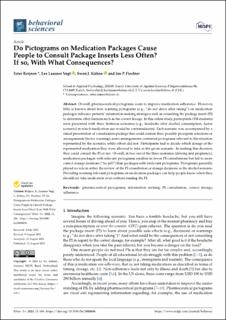Please use this identifier to cite or link to this item:
https://doi.org/10.21256/zhaw-28609Full metadata record
| DC Field | Value | Language |
|---|---|---|
| dc.contributor.author | Reijnen, Ester | - |
| dc.contributor.author | Laasner Vogt, Lea | - |
| dc.contributor.author | Kühne, Swen J. | - |
| dc.contributor.author | Fiechter, Jan P. | - |
| dc.date.accessioned | 2023-09-08T13:08:39Z | - |
| dc.date.available | 2023-09-08T13:08:39Z | - |
| dc.date.issued | 2023-08-21 | - |
| dc.identifier.issn | 2076-328X | de_CH |
| dc.identifier.uri | https://digitalcollection.zhaw.ch/handle/11475/28609 | - |
| dc.description.abstract | Overall, pharmaceutical pictograms seem to improve medication adherence. However, little is known about how warning pictograms (e.g., "do not drive after taking") on medication packages influence patients' information-seeking strategies such as consulting the package insert (PI) to determine other features such as the correct dosage. In this online study, participants (358 students) were presented with three fictitious scenarios (e.g., headache after alcohol consumption; factor scenario) in which medication use would be contraindicated. Each scenario was accompanied by a visual presentation of a medication package that could contain three possible pictogram selections or arrangements (factor warning); some arrangements contained pictograms relevant to the situation represented by the scenario, while others did not. Participants had to decide which dosage of the represented medication they were allowed to take in the given scenario. In making this decision, they could consult the PI or not. Overall, in two out of the three scenarios (driving and pregnancy), medication packages with relevant pictograms resulted in fewer PI consultations but led to more correct dosage decisions ("no pill") than packages with irrelevant pictograms. Pictograms generally played no role in either the review of the PI consultation or dosage decisions in the alcohol scenario. Providing warning-relevant pictograms on medication packages can help people know when they should not take medication even without reading the PI. | de_CH |
| dc.language.iso | en | de_CH |
| dc.publisher | MDPI | de_CH |
| dc.relation.ispartof | Behavioral Sciences | de_CH |
| dc.rights | http://creativecommons.org/licenses/by/4.0/ | de_CH |
| dc.subject | PI consultation | de_CH |
| dc.subject | Adherence | de_CH |
| dc.subject | Correct dosage | de_CH |
| dc.subject | Information seeking | de_CH |
| dc.subject | Pharmaceutical pictogram | de_CH |
| dc.subject.ddc | 158: Angewandte Psychologie | de_CH |
| dc.title | Do pictograms on medication packages cause people to consult package inserts less often? If so, with what consequences? | de_CH |
| dc.type | Beitrag in wissenschaftlicher Zeitschrift | de_CH |
| dcterms.type | Text | de_CH |
| zhaw.departement | Angewandte Psychologie | de_CH |
| zhaw.organisationalunit | Psychologisches Institut (PI) | de_CH |
| dc.identifier.doi | 10.3390/bs13080696 | de_CH |
| dc.identifier.doi | 10.21256/zhaw-28609 | - |
| dc.identifier.pmid | 37622836 | de_CH |
| zhaw.funding.eu | No | de_CH |
| zhaw.issue | 8 | de_CH |
| zhaw.originated.zhaw | Yes | de_CH |
| zhaw.pages.start | 696 | de_CH |
| zhaw.publication.status | publishedVersion | de_CH |
| zhaw.volume | 13 | de_CH |
| zhaw.publication.review | Peer review (Publikation) | de_CH |
| zhaw.webfeed | PI - Umwelt- und Nachhaltigkeitspsychologie | de_CH |
| zhaw.webfeed | Angewandte Kognitionspsychologie | de_CH |
| zhaw.author.additional | No | de_CH |
| zhaw.display.portrait | Yes | de_CH |
| Appears in collections: | Publikationen Angewandte Psychologie | |
Files in This Item:
| File | Description | Size | Format | |
|---|---|---|---|---|
| 2023_Reijnen-etal_Pictograms-on-medication-packages_behavioralsciences.pdf | 1.65 MB | Adobe PDF |  View/Open |
Show simple item record
Reijnen, E., Laasner Vogt, L., Kühne, S. J., & Fiechter, J. P. (2023). Do pictograms on medication packages cause people to consult package inserts less often? If so, with what consequences? Behavioral Sciences, 13(8), 696. https://doi.org/10.3390/bs13080696
Reijnen, E. et al. (2023) ‘Do pictograms on medication packages cause people to consult package inserts less often? If so, with what consequences?’, Behavioral Sciences, 13(8), p. 696. Available at: https://doi.org/10.3390/bs13080696.
E. Reijnen, L. Laasner Vogt, S. J. Kühne, and J. P. Fiechter, “Do pictograms on medication packages cause people to consult package inserts less often? If so, with what consequences?,” Behavioral Sciences, vol. 13, no. 8, p. 696, Aug. 2023, doi: 10.3390/bs13080696.
REIJNEN, Ester, Lea LAASNER VOGT, Swen J. KÜHNE und Jan P. FIECHTER, 2023. Do pictograms on medication packages cause people to consult package inserts less often? If so, with what consequences? Behavioral Sciences. 21 August 2023. Bd. 13, Nr. 8, S. 696. DOI 10.3390/bs13080696
Reijnen, Ester, Lea Laasner Vogt, Swen J. Kühne, and Jan P. Fiechter. 2023. “Do Pictograms on Medication Packages Cause People to Consult Package Inserts Less Often? If so, with What Consequences?” Behavioral Sciences 13 (8): 696. https://doi.org/10.3390/bs13080696.
Reijnen, Ester, et al. “Do Pictograms on Medication Packages Cause People to Consult Package Inserts Less Often? If so, with What Consequences?” Behavioral Sciences, vol. 13, no. 8, Aug. 2023, p. 696, https://doi.org/10.3390/bs13080696.
Items in DSpace are protected by copyright, with all rights reserved, unless otherwise indicated.